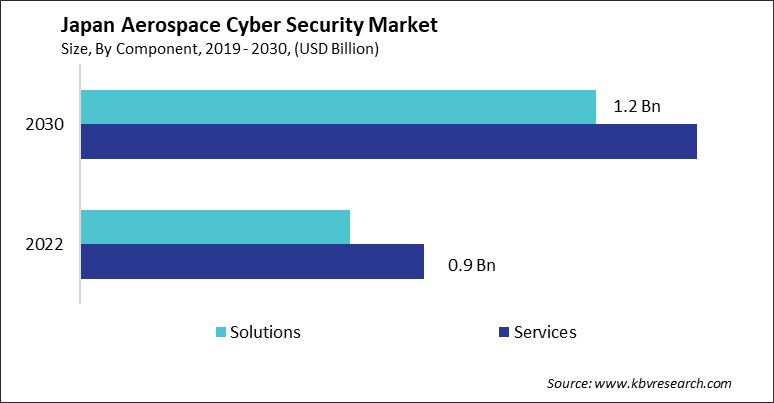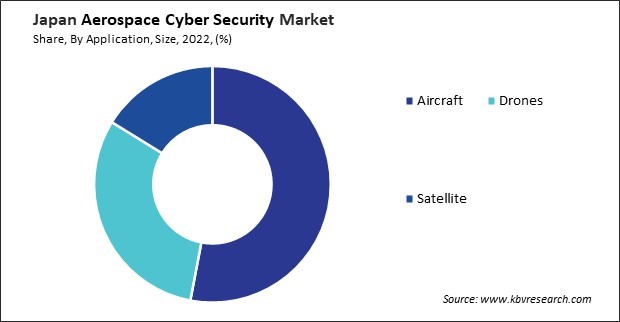Int'l : +1(646) 600-5072 | query@kbvresearch.com
Int'l : +1(646) 600-5072 | query@kbvresearch.com
Published Date : 02-Sep-2024 |
Pages: 74 |
Formats: PDF |
The Japan Aerospace Cyber Security Market size is expected to reach $2.7 Billion by 2030, rising at a market growth of 8.1% CAGR during the forecast period.
Japan's aerospace cyber security market has witnessed significant growth in recent years. Japan, a prominent player in the global aerospace sector, has recognized the importance of securing its critical infrastructure against cyber threats to ensure the safety and integrity of its aerospace systems. The growing sophistication of cyber threats has propelled aerospace companies in Japan to invest in advanced cyber security solutions. These solutions encompass various technologies and services, including network security, endpoint security, threat intelligence, and security analytics. By deploying these solutions, aerospace companies detect and mitigate cyber threats in real time, safeguarding their critical assets from potential attacks.

One of the key drivers of the aerospace cyber security market in Japan is the rapid digitalization of aerospace systems and processes. With the adoption of advanced technologies such as the Internet of Things (IoT), artificial intelligence (AI), and cloud computing, aerospace companies in Japan are increasingly vulnerable to cyber-attacks. According to the International Trade and Administration, the Internet of Things industry grew to $37.4 billion by 3.9% in 2020. As a result, there has been a growing emphasis on implementing robust cyber security measures to protect sensitive data and ensure the uninterrupted operation of aerospace systems.
Moreover, the Japanese government has actively promoted cyber security initiatives in the aerospace sector. With the establishment of regulatory frameworks and guidelines, the government aims to enhance the cyber resilience of aerospace companies and strengthen the overall security posture of the industry. Additionally, collaborations between government agencies, industry stakeholders, and cybersecurity firms have facilitated the sharing of best practices and threat intelligence, further bolstering the cyber defense capabilities of the aerospace sector in Japan.
The outbreak of the COVID-19 pandemic has also significantly impacted the aerospace cyber security market in Japan. As the pandemic forced many aerospace companies to adopt remote working arrangements and accelerate their digital transformation efforts, the attack surface for cyber threats expanded. In response to the heightened cyber security risks posed by the pandemic, aerospace companies in Japan ramped up their investments in cyber security solutions. Remote access technologies, endpoint security measures, and employee training programs were prioritized to mitigate the risks associated with remote work.
In recent years, Japan's aerospace industry has faced a mounting threat from ransomware attacks, posing significant challenges to cybersecurity measures within the sector. With its sensitive data and critical infrastructure, the aerospace sector has emerged as a prime target for cybercriminals seeking financial gain or strategic advantage. These attacks often exploit vulnerabilities in network systems to gain unauthorized access to sensitive information.
One of the primary reasons behind the rising number of ransomware attacks in the aerospace cyber security market in Japan is the growing interconnectedness of digital systems. According to the International Trade Administration, in 2022, the cyber security industry in Japan witnessed substantial growth, with an industry size of $3.6 billion, marking a notable 16% increase. The number of ransomware attacks reported to the National Police Agency in the first half of 2022 was 114, a steady increase since 2020. As aircraft become more technologically advanced, incorporating features such as in-flight connectivity and remote monitoring, they become more susceptible to cyber threats.
Additionally, the geopolitical landscape plays a significant role in targeting aerospace companies in Japan. State-sponsored cyberattacks have become a real concern as tensions rise between nations, with adversaries seeking to disrupt critical infrastructure and gain access to classified information. With its involvement in defense contracts and national security initiatives, the aerospace industry presents an attractive target for such attacks.
Furthermore, the financial implications of ransomware attacks can be crippling for aerospace companies, leading to costly downtime, loss of intellectual property, and damage to reputation. Therefore, the convergence of technological advancements, geopolitical tensions, and financial motivations underscores the urgent need for robust cybersecurity measures to safeguard Japan's aerospace industry against ransomware threats.
Japan's aerospace cyber security market is experiencing a significant shift due to the increasing connectivity of aircraft and related systems. As aircraft become more technologically advanced, they rely heavily on interconnected systems for navigation, communication, and operation. Japan, a technologically advanced nation with a robust aerospace industry, is at the forefront of this evolution. The country's aerospace sector encompasses various stakeholders, including aircraft manufacturers, airlines, defense contractors, and government agencies.
One of the key challenges in the aerospace cyber security market is ensuring the integrity and confidentiality of data transmitted between aircraft systems and ground-based infrastructure. Hackers may attempt to exploit vulnerabilities in communication protocols or onboard software to gain unauthorized access to critical systems or sensitive information. For example, a cyber-attack can disrupt flight operations, compromise passenger safety, or steal valuable intellectual property.
To mitigate these risks, Japanese aerospace companies are investing in advanced cybersecurity solutions tailored to the unique requirements of the aviation industry. Furthermore, regulatory bodies such as the Japan Civil Aviation Bureau (JCAB) are implementing stringent cybersecurity standards and guidelines to ensure the safety and security of air travel. Compliance with these regulations is essential for aerospace companies seeking to operate in the Japanese industry and maintain the trust of passengers and partners. Thus, Japan's aerospace industry prioritizes investment in advanced cybersecurity measures and adherence to stringent regulatory standards to safeguard air travel integrity and passenger safety.

In Japan, the aerospace industry is increasingly recognizing the importance of cybersecurity in protecting critical infrastructure, data, and systems. One notable player in the Japanese aerospace cyber security market is NEC Corporation. NEC is a leading technology company with a strong presence in cybersecurity solutions. The company offers a range of cybersecurity products and services to protect aerospace systems and data from cyber threats. NEC's cybersecurity solutions include threat detection, vulnerability management, and incident response, leveraging advanced technologies such as artificial intelligence and big data analytics to enhance security.
Another prominent player in Japan's aerospace cyber security market is Mitsubishi Electric Corporation. Mitsubishi Electric is a diversified electronics and engineering company with aerospace systems and cybersecurity expertise. The company provides various cybersecurity solutions for aerospace applications, including secure communications, network security, and data protection. Mitsubishi Electric's cybersecurity offerings are designed to meet the stringent requirements of aerospace customers, ensuring the integrity and confidentiality of critical systems and information.
Fujitsu Limited is also a significant player in Japan's aerospace cyber security market. The company is a global IT services and solutions provider focusing on cybersecurity. Fujitsu offers a comprehensive suite of cybersecurity solutions for aerospace and defense applications, including threat intelligence, security monitoring, and incident response. The company's cybersecurity offerings are backed by its industry expertise and commitment to innovation, helping aerospace customers effectively detect and mitigate cyber threats.
In addition to these major players, several smaller companies in Japan specialize in providing cybersecurity solutions for the aerospace industry. These include niche cybersecurity firms that focus exclusively on aerospace applications and IT and cybersecurity service providers that offer tailored solutions for aerospace customers. These companies play a crucial role in addressing the unique cybersecurity challenges faced by Japan's aerospace industry, helping protect sensitive data, critical systems, and intellectual property from cyber threats.
By Component
By Application
By Deployment
By Type